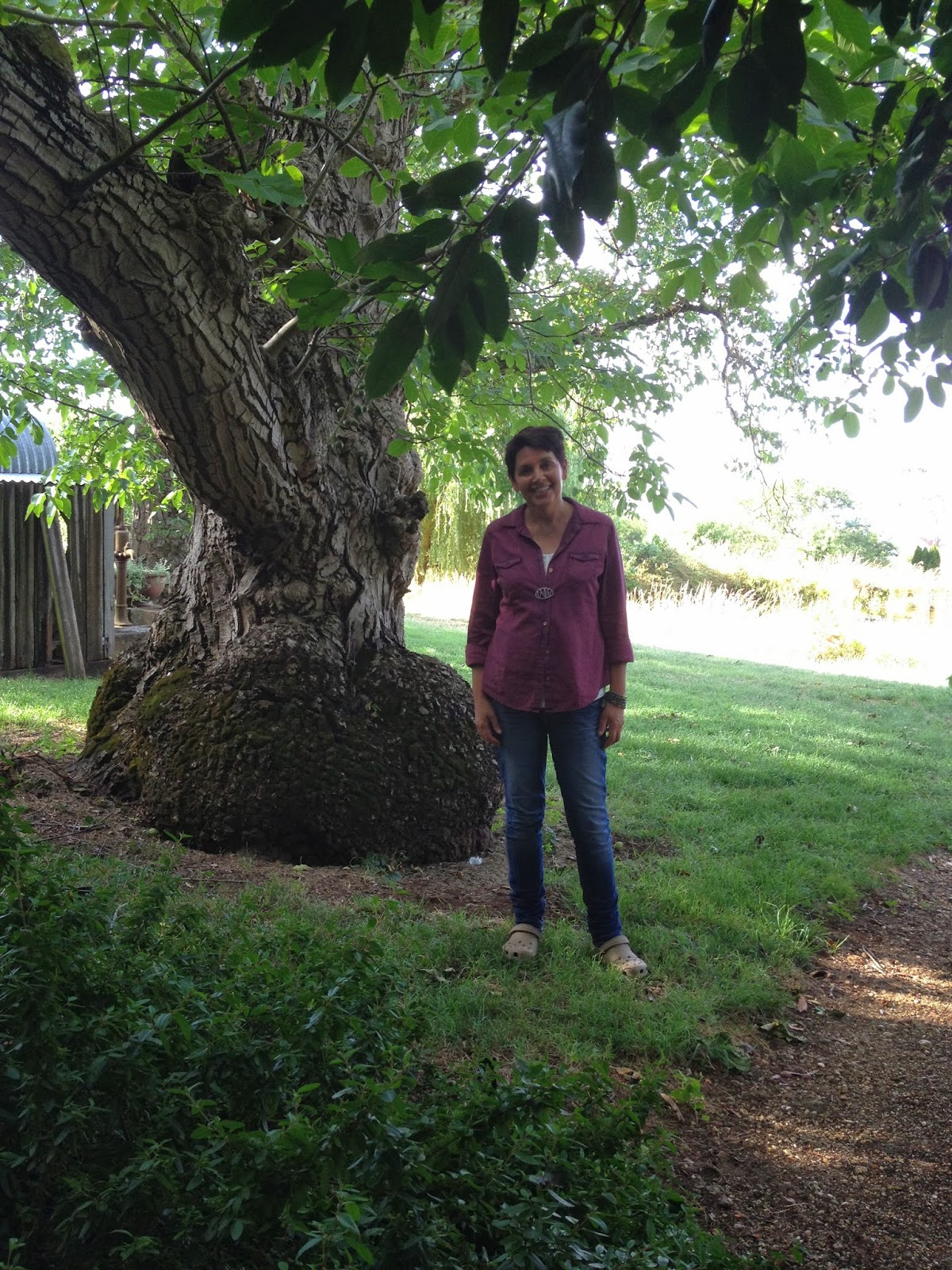Linda Hamilton has taken on a mammoth project. Her farming property 'Lynbank' sits on top of a ridge overlooking the Loddon Valley. The original owners of the farm, first established in the 1860's, planted a large European garden. Huge old pines are a reminder of this first garden, planted around the house paddock to ward off the fierce south easterly winds. Other tree survivors of this earlier age are the enormous walnuts, oaks, cedars, cypress and elms. The original farmhouse was burnt down in a bushfire in the early 20th century, but these old trees survived.
 |
| Linda beside a very old walnut tree |
In the early 1990's, to take advantage of the magnificent views, a mediterranean villa was built on the highest but most exposed part of the property. This imposing building with its blue wooden shutters, large patio and sweeping driveway made a strong statement on the surrounding Australian landscape.
The house was surrounded by an Italianate garden, a European style of highly floriferous but also heavily water dependent plants. In formal European tradition, the beds of rhododendrons, azaleas, hydrangeas and annuals required constant watering from the dam, fed by an underground bore.
Hedges of buddleias and conifers added to the formality of the garden.
 |
| Three gardens in one: old pine trees c 1860's, fountain c 1990 softened by Linda's plantings. |
Linda, quite new to gardening, knew that something was wrong- the house and garden didn't fit the landscape. The garden needed 'opening out' to incorporate the broader and most beautiful views.
Facing this huge challenge, she undertook a course in garden design, studying Brookes, Pearson, Piet Oudolf and their Australian counterparts.
With this new knowledge and many conversations with gardening friends, Linda set out to transform the garden to meld with the Australian landscape, whilst maintaining the best features of previous gardens. Firstly, she allowed some heavily water-dependent plants to die. Those that survived were nurtured, along with the new plantings. Next, she removed the buddleia hedges and some of the newer conifer plantings that obscured the broader views of the garden. Now the beauty of the old oak tree trunks could be seen, along with glimpses of the blue hills beyond.
 |
| Opening up the landscape: An old pump and blue hills beyond |
 |
| Archways and small paths create mystery |
Linda has learned the joys of the bobcat. Now straight lines are being transformed and curves are entering the landscape, reflecting the rolling hills beyond. Removal of some mid storey plants has allowed for the development of archways over small pathways throughout the garden, adding a sense of mystery to a garden stroll. Water dependent annuals and perrenials are gradually being replaced with swathes of poas, correas, scaevolas and other picturesque but drought hardy plants. Stands of snow gums soften the more formal lines of their exotic counterparts. An imposing formality has been replaced by a more intimate space.
 |
| Drought tolerant plants reduce water use |
This gardening experience has been a major challenge for Linda. "I've really struggled with this garden; [with] its size and what it represented to me - materialism and Western affluence". She learned to let go of some preconceived traditional concepts of garden design, of lines and neat edges. She has developed 'a shared relationship' with the garden, respecting the natural ebbs and flows of its plants. "The garden is my greatest teacher and I have discovered so much about who I am".
Central to the changes that Linda has made to her place is the the notion of sustainability. Firstly, mindfulness of finite natural resources such as water. Secondly the transformation of a garden which is alienated from its environment to a space that encourages local wildlife and welcomes human visitors. And finally, as Linda explains "the garden is so big and overwhelming, it must be sustainable for me. How can I work with the garden so that it sustains me?
There is a balancing act between changing things to reveal the spirit of the place [but at the same time] not making more work".
Linda gains immense pleasure from her garden. She explains that a garden can " bring you really close and embrace you". Nevertheless, there is still a great deal of work to be done. Sustained by her family and friends, and with the help of the trusty bobcat, she is gradually transforming a beautiful but alienated garden into one that retains its beauty while fitting comfortably into its place. It's a reciprocal relationship; Linda nurtures the garden and in turn, the garden nurtures her.


No comments:
Post a Comment